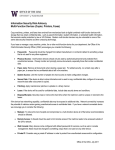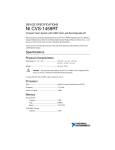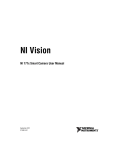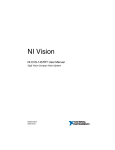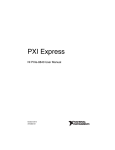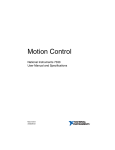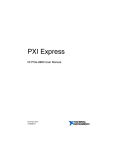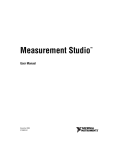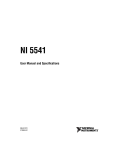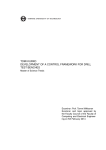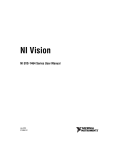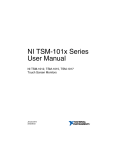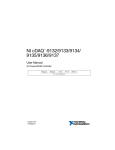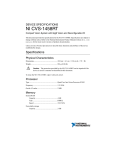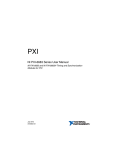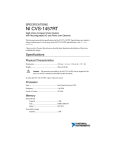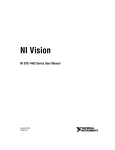Download NI CVS-1459RT User Manual
Transcript
NI Vision NI CVS-1459RT User Manual Compact Vision System with USB3 Vision and Reconfigurable I/O NI CVS-1459RT User Manual September 2014 374248A-01 Support Worldwide Technical Support and Product Information ni.com Worldwide Offices Visit ni.com/niglobal to access the branch office Web sites, which provide up-to-date contact information, support phone numbers, email addresses, and current events. National Instruments Corporate Headquarters 11500 North Mopac Expressway Austin, Texas 78759-3504 USA Tel: 512 683 0100 For further support information, refer to the NI Services appendix. To comment on National Instruments documentation, refer to the National Instruments Web site at ni.com/info and enter the Info Code feedback. © 2014 National Instruments. All rights reserved. Important Information Limited Warranty This document is provided ‘as is’ and is subject to being changed, without notice, in future editions. For the latest version, refer to ni.com/manuals. NI reviews this document carefully for technical accuracy; however, NI MAKES NO EXPRESS OR IMPLIED WARRANTIES AS TO THE ACCURACY OF THE INFORMATION CONTAINED HEREIN AND SHALL NOT BE LIABLE FOR ANY ERRORS. NI warrants that its hardware products will be free of defects in materials and workmanship that cause the product to fail to substantially conform to the applicable NI published specifications for one (1) year from the date of invoice. For a period of ninety (90) days from the date of invoice, NI warrants that (i) its software products will perform substantially in accordance with the applicable documentation provided with the software and (ii) the software media will be free from defects in materials and workmanship. If NI receives notice of a defect or non-conformance during the applicable warranty period, NI will, in its discretion: (i) repair or replace the affected product, or (ii) refund the fees paid for the affected product. Repaired or replaced Hardware will be warranted for the remainder of the original warranty period or ninety (90) days, whichever is longer. If NI elects to repair or replace the product, NI may use new or refurbished parts or products that are equivalent to new in performance and reliability and are at least functionally equivalent to the original part or product. You must obtain an RMA number from NI before returning any product to NI. NI reserves the right to charge a fee for examining and testing Hardware not covered by the Limited Warranty. This Limited Warranty does not apply if the defect of the product resulted from improper or inadequate maintenance, installation, repair, or calibration (performed by a party other than NI); unauthorized modification; improper environment; use of an improper hardware or software key; improper use or operation outside of the specification for the product; improper voltages; accident, abuse, or neglect; or a hazard such as lightning, flood, or other act of nature. THE REMEDIES SET FORTH ABOVE ARE EXCLUSIVE AND THE CUSTOMER’S SOLE REMEDIES, AND SHALL APPLY EVEN IF SUCH REMEDIES FAIL OF THEIR ESSENTIAL PURPOSE. EXCEPT AS EXPRESSLY SET FORTH HEREIN, PRODUCTS ARE PROVIDED "AS IS" WITHOUT WARRANTY OF ANY KIND AND NI DISCLAIMS ALL WARRANTIES, EXPRESSED OR IMPLIED, WITH RESPECT TO THE PRODUCTS, INCLUDING ANY IMPLIED WARRANTIES OF MERCHANTABILITY, FITNESS FOR A PARTICULAR PURPOSE, TITLE OR NON-INFRINGEMENT, AND ANY WARRANTIES THAT MAY ARISE FROM USAGE OF TRADE OR COURSE OF DEALING. NI DOES NOT WARRANT, GUARANTEE, OR MAKE ANY REPRESENTATIONS REGARDING THE USE OF OR THE RESULTS OF THE USE OF THE PRODUCTS IN TERMS OF CORRECTNESS, ACCURACY, RELIABILITY, OR OTHERWISE. NI DOES NOT WARRANT THAT THE OPERATION OF THE PRODUCTS WILL BE UNINTERRUPTED OR ERROR FREE. In the event that you and NI have a separate signed written agreement with warranty terms covering the products, then the warranty terms in the separate agreement shall control. Copyright Under the copyright laws, this publication may not be reproduced or transmitted in any form, electronic or mechanical, including photocopying, recording, storing in an information retrieval system, or translating, in whole or in part, without the prior written consent of National Instruments Corporation. National Instruments respects the intellectual property of others, and we ask our users to do the same. NI software is protected by copyright and other intellectual property laws. Where NI software may be used to reproduce software or other materials belonging to others, you may use NI software only to reproduce materials that you may reproduce in accordance with the terms of any applicable license or other legal restriction. End-User License Agreements and Third-Party Legal Notices You can find end-user license agreements (EULAs) and third-party legal notices in the following locations: • Notices are located in the <National Instruments>\_Legal Information and <National Instruments> directories. • EULAs are located in the <National Instruments>\Shared\MDF\Legal\license directory. • Review <National Instruments>\_Legal Information.txt for information on including legal information in installers built with NI products. U.S. Government Restricted Rights If you are an agency, department, or other entity of the United States Government (“Government”), the use, duplication, reproduction, release, modification, disclosure or transfer of the technical data included in this manual is governed by the Restricted Rights provisions under Federal Acquisition Regulation 52.227-14 for civilian agencies and Defense Federal Acquisition Regulation Supplement Section 252.227-7014 and 252.227-7015 for military agencies. Trademarks Refer to the NI Trademarks and Logo Guidelines at ni.com/trademarks for more information on National Instruments trademarks. ARM, Keil, and µVision are trademarks or registered of ARM Ltd or its subsidiaries. LEGO, the LEGO logo, WEDO, and MINDSTORMS are trademarks of the LEGO Group. TETRIX by Pitsco is a trademark of Pitsco, Inc. FIELDBUS FOUNDATION™ and FOUNDATION™ are trademarks of the Fieldbus Foundation. EtherCAT® is a registered trademark of and licensed by Beckhoff Automation GmbH. CANopen® is a registered Community Trademark of CAN in Automation e.V. DeviceNet™ and EtherNet/IP™ are trademarks of ODVA. Go!, SensorDAQ, and Vernier are registered trademarks of Vernier Software & Technology. Vernier Software & Technology and vernier.com are trademarks or trade dress. Xilinx is the registered trademark of Xilinx, Inc. Taptite and Trilobular are registered trademarks of Research Engineering & Manufacturing Inc. FireWire® is the registered trademark of Apple Inc. Linux® is the registered trademark of Linus Torvalds in the U.S. and other countries. Handle Graphics®, MATLAB®, Real-Time Workshop®, Simulink®, Stateflow®, and xPC TargetBox® are registered trademarks, and TargetBox™ and Target Language Compiler™ are trademarks of The MathWorks, Inc. Tektronix®, Tek, and Tektronix, Enabling Technology are registered trademarks of Tektronix, Inc. The Bluetooth® word mark is a registered trademark owned by the Bluetooth SIG, Inc. The ExpressCard™ word mark and logos are owned by PCMCIA and any use of such marks by National Instruments is under license. The mark LabWindows is used under a license from Microsoft Corporation. Windows is a registered trademark of Microsoft Corporation in the United States and other countries. Other product and company names mentioned herein are trademarks or trade names of their respective companies. Members of the National Instruments Alliance Partner Program are business entities independent from National Instruments and have no agency, partnership, or joint-venture relationship with National Instruments. Patents For patents covering National Instruments products/technology, refer to the appropriate location: Help»Patents in your software, the patents.txt file on your media, or the National Instruments Patent Notice at ni.com/patents. Export Compliance Information Refer to the Export Compliance Information at ni.com/legal/export-compliance for the National Instruments global trade compliance policy and how to obtain relevant HTS codes, ECCNs, and other import/export data. WARNING REGARDING USE OF NATIONAL INSTRUMENTS PRODUCTS YOU ARE ULTIMATELY RESPONSIBLE FOR VERIFYING AND VALIDATING THE SUITABILITY AND RELIABILITY OF THE PRODUCTS WHENEVER THE PRODUCTS ARE INCORPORATED IN YOUR SYSTEM OR APPLICATION, INCLUDING THE APPROPRIATE DESIGN, PROCESS, AND SAFETY LEVEL OF SUCH SYSTEM OR APPLICATION. PRODUCTS ARE NOT DESIGNED, MANUFACTURED, OR TESTED FOR USE IN LIFE OR SAFETY CRITICAL SYSTEMS, HAZARDOUS ENVIRONMENTS OR ANY OTHER ENVIRONMENTS REQUIRING FAIL-SAFE PERFORMANCE, INCLUDING IN THE OPERATION OF NUCLEAR FACILITIES; AIRCRAFT NAVIGATION; AIR TRAFFIC CONTROL SYSTEMS; LIFE SAVING OR LIFE SUSTAINING SYSTEMS OR SUCH OTHER MEDICAL DEVICES; OR ANY OTHER APPLICATION IN WHICH THE FAILURE OF THE PRODUCT OR SERVICE COULD LEAD TO DEATH, PERSONAL INJURY, SEVERE PROPERTY DAMAGE OR ENVIRONMENTAL HARM (COLLECTIVELY, “HIGH-RISK USES”). FURTHER, PRUDENT STEPS MUST BE TAKEN TO PROTECT AGAINST FAILURES, INCLUDING PROVIDING BACK-UP AND SHUT-DOWN MECHANISMS. NI EXPRESSLY DISCLAIMS ANY EXPRESS OR IMPLIED WARRANTY OF FITNESS OF THE PRODUCTS OR SERVICES FOR HIGH-RISK USES. Compliance Electromagnetic Compatibility Information This hardware has been tested and found to comply with the applicable regulatory requirements and limits for electromagnetic compatibility (EMC) as indicated in the hardware’s Declaration of Conformity (DoC)1. These requirements and limits are designed to provide reasonable protection against harmful interference when the hardware is operated in the intended electromagnetic environment. In special cases, for example when either highly sensitive or noisy hardware is being used in close proximity, additional mitigation measures may have to be employed to minimize the potential for electromagnetic interference. While this hardware is compliant with the applicable regulatory EMC requirements, there is no guarantee that interference will not occur in a particular installation. To minimize the potential for the hardware to cause interference to radio and television reception or to experience unacceptable performance degradation, install and use this hardware in strict accordance with the instructions in the hardware documentation and the DoC1. If this hardware does cause interference with licensed radio communications services or other nearby electronics, which can be determined by turning the hardware off and on, you are encouraged to try to correct the interference by one or more of the following measures: • Reorient the antenna of the receiver (the device suffering interference). • Relocate the transmitter (the device generating interference) with respect to the receiver. • Plug the transmitter into a different outlet so that the transmitter and the receiver are on different branch circuits. Some hardware may require the use of a metal, shielded enclosure (windowless version) to meet the EMC requirements for special EMC environments such as, for marine use or in heavy industrial areas. Refer to the hardware’s user documentation and the DoC1 for product installation requirements. When the hardware is connected to a test object or to test leads, the system may become more sensitive to disturbances or may cause interference in the local electromagnetic environment. Operation of this hardware in a residential area is likely to cause harmful interference. Users are required to correct the interference at their own expense or cease operation of the hardware. Changes or modifications not expressly approved by National Instruments could void the user’s right to operate the hardware under the local regulatory rules. Caution To ensure the specified EMC performance, operate this product only with shielded cables and accessories. 1 The Declaration of Conformity (DoC) contains important EMC compliance information and instructions for the user or installer. To obtain the DoC for this product, visit ni.com/certification, search by model number or product line, and click the appropriate link in the Certification column. Contents About This Manual Conventions ...................................................................................................................... ix Related Documentation .................................................................................................... ix Resources for NI Vision Builder AI Users............................................................... x Resources for NI LabVIEW, NI Vision Development Module, and NI Vision Acquisition Software Users .................................................................. x Chapter 1 NI CVS-1459RT Overview About the NI CVS-1459RT .............................................................................................. 1-1 Hardware Overview.......................................................................................................... 1-1 Software Overview ........................................................................................................... 1-2 NI Vision Builder for Automated Inspection ........................................................... 1-3 LabVIEW.................................................................................................................. 1-3 LabVIEW Real-Time Module .......................................................................... 1-3 LabVIEW FPGA Module................................................................................. 1-3 NI Vision Development Module ...................................................................... 1-3 NI Vision Acquisition Software ....................................................................... 1-4 Chapter 2 LED Indicators and the RESET Button LED Indicators ................................................................................................................. 2-1 STATUS LED .......................................................................................................... 2-2 PWR/FAULT LED................................................................................................... 2-3 USER1/USER2 LEDs .............................................................................................. 2-3 Ethernet LEDs .......................................................................................................... 2-3 Using the RESET Button.................................................................................................. 2-4 Safe Mode................................................................................................................. 2-5 IP Reset..................................................................................................................... 2-5 Chapter 3 Connector Pinouts Chassis Grounding Screw................................................................................................. 3-3 Power Input Connectors ................................................................................................... 3-4 Ethernet Port ..................................................................................................................... 3-5 USB 2.0 Ports ................................................................................................................... 3-6 RS-485/422/232 Serial Port.............................................................................................. 3-6 VGA Port .......................................................................................................................... 3-7 USB3 Vision Ports............................................................................................................ 3-9 Digital I/O......................................................................................................................... 3-10 Wiring an Isolated Input ........................................................................................... 3-12 © National Instruments | vii Contents Wiring an Isolated Output......................................................................................... 3-12 Connecting to Differential I/O .................................................................................. 3-13 TTL I/O..................................................................................................................... 3-15 Chapter 4 Deployment Connecting Multiple NI CVS-1459RT Devices ............................................................... 4-1 Chapter 5 BIOS Configuration and System Recovery Entering BIOS Setup ........................................................................................................ 5-1 Main Menu................................................................................................................ 5-2 Advanced Menu ........................................................................................................ 5-2 Power/Wake Configuration Submenu .............................................................. 5-2 Serial Port Configuration Submenu .................................................................. 5-3 SATA Configuration Submenu ........................................................................ 5-3 USB Configuration Submenu ........................................................................... 5-3 Boot Menu ................................................................................................................ 5-3 Boot Settings Configuration Submenu ............................................................. 5-4 Device BBS Priority Submenus........................................................................ 5-4 Save & Exit Menu..................................................................................................... 5-5 Restoring the NI CVS-1459RT to Factory Default Condition ......................................... 5-6 Appendix A Troubleshooting Software Configuration Problems .................................................................................... A-1 The NI CVS-1459RT Does Not Appear in MAX or in Vision Builder AI .............. A-1 No Software is Installed............................................................................................ A-2 No Camera Found..................................................................................................... A-2 Hardware Problems........................................................................................................... A-3 Cannot Drive Isolated Outputs ................................................................................. A-3 Runaway Startup Application ................................................................................... A-3 LED Error Indications .............................................................................................. A-3 PWR/FAULT LED Is Not Lit When the NI CVS-1459RT is Powered On ............. A-3 Appendix B Mounting Information Clearance Requirements ................................................................................................... B-5 Appendix C NI Services viii | ni.com About This Manual This manual contains detailed electrical and mechanical information for the National Instruments CVS-1459RT. Conventions The following conventions appear in this manual: This icon denotes a note, which alerts you to important information. This icon denotes a caution, which advises you of precautions to take to avoid injury, data loss, or a system crash. When this symbol is marked on a product, it denotes a warning advising you to take precautions to avoid electrical shock. bold Bold text denotes items that you must select or click in the software, such as menu items and dialog box options. Bold text also denotes parameter names. italic Italic text denotes variables, emphasis, a cross-reference, or an introduction to a key concept. Italic text also denotes text that is a placeholder for a word or value that you must supply. monospace Text in this font denotes text or characters that you should enter from the keyboard, sections of code, programming examples, and syntax examples. This font is also used for the proper names of disk drives, paths, directories, programs, subprograms, subroutines, device names, functions, operations, variables, filenames, and extensions. monospace italic Italic text in this font denotes text that is a placeholder for a word or value that you must supply. Related Documentation The following documents contain information that you may find helpful as you read this manual: • NI CVS-1459RT Specifications—Contains detailed specifications for the NI CVS-1459RT. • NI CVS-1459RT Getting Started Guide—Explains how to install and configure the software necessary to use the NI CVS-1459RT, and how to get started using the NI CVS-1459RT hardware. • NI CVS I/O Accessory User Manual—Contains installation and operation instructions for the CVS I/O Accessory. © National Instruments | ix About This Manual Resources for NI Vision Builder AI Users Refer to the NI Vision Builder for Automated Inspection Tutorial to learn how to perform basic machine vision techniques using Vision Builder AI. You can access the NI Vision Builder for Automated Inspection Tutorial and other documentation by selecting Start»All Programs» National Instruments»Vision Builder AI»Documentation. You can also access context help within Vision Builder AI by clicking the Show Context Help button on the Vision Builder AI toolbar. Examples of common Vision Builder AI inspections are installed to the <Vision Builder AI>\Examples directory, where <Vision Builder AI> is the location Vision Builder AI is installed. NI Vision Builder for Automated Inspection: Configuration Help—Contains information about using the Vision Builder for Automated Inspection Configuration Interface to create a machine vision application. NI Vision Builder for Automated Inspection: Inspection Help—Contains information about running applications created with Vision Builder for Automated Inspection in the Vision Builder Automated Inspection Interface. Resources for NI LabVIEW, NI Vision Development Module, and NI Vision Acquisition Software Users Documentation for LabVIEW, the LabVIEW Real-Time Module, and the LabVIEW FPGA Module is available from the Help menu on the LabVIEW toolbar. You can access documentation for the NI Vision Development Module by selecting Start»All Programs» National Instruments»Vision»Documentation»NI Vision. Documentation for the NI-IMAQdx driver software is available by selecting Start» All Programs»National Instruments»Vision»Documentation»NI-IMAQdx. Documentation for the NI-IMAQ I/O driver software is available by selecting Start» All Programs»National Instruments»Vision»Documentation»NI-IMAQ IO. Documentation for the MAX configuration software is available from the Help menu on the MAX toolbar. Specific information about using MAX with NI Vision hardware is available by selecting Help»Help Topics»NI Vision»NI-IMAQdx. National Instruments Example Finder—LabVIEW contains an extensive library of VIs and example programs. To access the NI Example Finder, open LabVIEW and select Help»Find Examples. Visit the NI Developer Zone at ni.com/zone for the latest example programs, tutorials, technical presentations, and a community area where you can share ideas, questions, and source code with developers around the world. x | ni.com NI CVS-1459RT Overview 1 This chapter provides an overview of the features and components of the National Instruments CVS-1459RT Compact Vision System. About the NI CVS-1459RT The NI CVS-1459RT is a real-time imaging system that acquires, processes, and displays images from USB3 Vision cameras. The NI CVS-1459RT also provides multiple digital input/output (I/O) options for communicating with external devices to configure and start an inspection and to indicate results. An Ethernet connection between the NI CVS-1459RT and a development computer allows you to display measurement results and status information and to configure the NI CVS-1459RT settings. When configured, the NI CVS-1459RT can run applications without a connection to the development computer. Hardware Overview The NI CVS-1459RT front panel consists of a VGA connector, RJ50 serial port, two USB 2.0 ports, a 10/100/1000 Ethernet connector, and two USB3 Vision ports. The NI CVS-1459RT front panel also includes LEDs for communicating system status and a 44-pin Digital I/O port. The Digital I/O port offers 8 isolated inputs, 8 isolated outputs, 2 bidirectional differential I/O (RS-422) or single-ended input lines that can be used with a quadrature encoder, and 8 bidirectional TTL lines. Figure 1-1 shows the NI CVS-1459RT front panel connectors. © National Instruments | 1-1 Chapter 1 NI CVS-1459RT Overview Figure 1-1. NI CVS-1459RT Front Panel Connectors NI CVS-1459RT Compact Vision System STATUS USER1 USER2 PWR/ FAULT 4 0 ACT/ LINK 5 10/100/ 1000 1 3 2 DIGITAL I/O 6 1 RESET 1 2 3 VGA Connector RJ50 Serial Port USB 2.0 Ports 4 5 6 RJ45 Gigabit Ethernet Network Port USB3 Vision Ports 44-pin Digital I/O Connector Software Overview Developing machine vision applications with the NI CVS-1459RT requires one of the following software options: • NI Vision Builder for Automated Inspection (Vision Builder AI) 2014 or later • LabVIEW 2014 or later; LabVIEW Real-Time 2014 or later; the NI Vision Development Module 2014 or later; and NI-IMAQdx 14.0 or later driver software, included with NI Vision Acquisition Software August 2014 The NI CVS-1459RT has a user-reconfigurable FPGA that allows the I/O to be configured for particular applications. Different configurations are referred to as hardware personalities, and are defined by bitfiles. Use the following software to use and reconfigure the FPGA I/O. • LabVIEW FPGA Module 2012 or later—You must install the LabVIEW FPGA Module to reconfigure the default personality of the NI CVS-1459RT FPGA. • NI-IMAQ I/O 14.0 or later driver software, included with NI Vision Acquisition Software August 2014—NI-IMAQ I/O is required to use the default personality of the NI CVS-1459RT in LabVIEW, or to reconfigure the default personality of the NI CVS-1459RT I/O in the LabVIEW FPGA Module. 1-2 | ni.com NI CVS-1459RT User Manual The installation and configuration process for each development environment is different. Refer to the NI CVS-1459RT Getting Started Guide for installation and configuration instructions. The following sections describe the software options. For detailed information about individual software packages, refer to the documentation specific to the software. NI Vision Builder for Automated Inspection Vision Builder AI is configurable machine vision software that you can use to prototype, benchmark, and deploy machine vision applications. Creating applications in Vision Builder AI does not require programming. It also allows you to easily configure and benchmark a sequence of visual inspection steps, as well as deploy the visual inspection system for automated inspection. With Vision Builder AI, you can perform powerful visual inspection tasks and make decisions based on the results of individual tasks. You can also migrate your configured inspection to LabVIEW, extending the capabilities of your applications if necessary. Vision Builder AI allows you to remotely configure and control the NI CVS-1459RT. LabVIEW LabVIEW is a graphical programming environment for developing flexible and scalable applications. LabVIEW Real-Time Module The LabVIEW Real-Time Module combines LabVIEW graphical programming with the power of real-time (RT) hardware, such as the NI CVS-1459RT, enabling you to build deterministic, real-time systems. You develop VIs in LabVIEW and embed the VIs on RT targets. For more information about the LabVIEW Real-Time Module, refer to the LabVIEW Help. LabVIEW FPGA Module The LabVIEW FPGA Module extends the LabVIEW graphical development platform to target field-programmable gate arrays (FPGAs) on NI reconfigurable I/O (RIO) hardware. LabVIEW FPGA enables developers to more efficiently and effectively design complex systems by providing a highly integrated development environment, a large ecosystem of IP libraries, a high fidelity simulator, and debugging features. NI Vision Development Module The NI Vision Development Module is an image processing and analysis library with hundreds of functions for the following common machine vision tasks: • Pattern matching • Particle analysis • Gauging • Taking measurements • Grayscale, color, and binary image display © National Instruments | 1-3 Chapter 1 NI CVS-1459RT Overview Using the NI Vision Development Module, imaging novices and experts can program the most basic or complicated image applications without knowledge of particular algorithm implementations. NI Vision Assistant, which is included with the NI Vision Development Module, is an interactive prototyping tool for machine vision and scientific imaging developers. With Vision Assistant, you can prototype vision applications quickly and test how various vision image processing functions work. Using the Vision Assistant LabVIEW VI creation wizard, you can create LabVIEW VI block diagrams that perform the prototype you created in Vision Assistant. You can use them in LabVIEW to add functionality to the generated VI. For information about how to use the NI Vision Development Module with LabVIEW, refer to the NI Vision for LabVIEW Help. NI Vision Acquisition Software The NI CVS-1459RT ships with the latest version of NI Vision Acquisition Software, which contains all of the drivers in the NI Vision product line. With NI Vision Acquisition Software, you can quickly and easily start your applications without having to program the device at the register level. NI Vision Acquisition Software has an extensive library of functions—such as routines for video configuration, continuous and single shot image acquisition, memory buffer allocation, trigger control, and device configuration—that you can call from the application development environment. NI Vision Acquisition Software contains the following software for use with the NI CVS-1459RT: • NI-IMAQdx—Controls USB3 Vision cameras connected to the NI CVS-1459RT. NI-IMAQdx includes an extensive library of VIs you can call from LabVIEW. These VIs include routines for video configuration, continuous and single-shot image acquisition, trigger control, and register-level camera configuration. NI-IMAQdx software performs all functions necessary for acquiring and saving images. • NI-IMAQ I/O—Controls the reconfigurable digital I/O on the NI CVS-1459RT. • NI Measurement & Automation Explorer (NI MAX)—Use MAX to configure the NI CVS-1459RT. 1-4 | ni.com 2 LED Indicators and the RESET Button This chapter provides information about the location and functionality of the LED indicators and the RESET button on the NI CVS-1459RT. LED Indicators Figure 2-1 shows the LEDs on the NI CVS-1459RT. Figure 2-1. LED Indicators NI CVS-1459RT Compact Vision System PWR/ FAULT STATUS USER1 USER2 0 STATUS PWR/ FAULT USER2 USER1 ACT/ LINK 10/100/ 1000 1 DIGITAL I/O RESET © National Instruments | 2-1 Chapter 2 LED Indicators and the RESET Button STATUS LED The following table describes the STATUS LED indications. Table 2-1. STATUS LED Indications STATUS LED (Amber) State OFF The NI CVS-1459RT initialized successfully and is ready for use. 2 blinks There is no software installed, which is the out-of-box state, or the NI CVS-1459RT has detected an error in its software. The device has automatically started up into safe mode. This usually occurs when an attempt to upgrade the software is interrupted or if system files are deleted from the NI CVS-1459RT. Reinstall software on the NI CVS-1459RT. Refer to the NI CVS-1459RT Getting Started Guide for information about installing software. 3 blinks The NI CVS-1459RT has booted into safe mode. Refer to the Safe Mode section for information about the safe mode state. 4 blinks The NI CVS-1459RT has experienced two consecutive software exceptions. The NI CVS-1459RT automatically restarts after an exception. After the second exception, the NI CVS-1459RT remains in the exception state, alerting you to resolve the problem. Reinstall software on the NI CVS-1459RT or contact National Instruments for assistance. Refer to the NI CVS-1459RT Getting Started Guide for information about installing software on the NI CVS-1459RT. Continuous blink The NI CVS-1459RT has not booted into NI Linux Real-Time. The controller either booted into an unsupported operating system, was interrupted during the boot process, or detected an unrecoverable software error. ON 2-2 NI CVS-1459RT State | ni.com The NI CVS-1459RT is booting up. NI CVS-1459RT User Manual PWR/FAULT LED The following table describes the PWR/FAULT LED indications. Table 2-2. PWR/FAULT LED Indications PWR/FAULT LED (Green/Red) State OFF ON - Green Blinking - Red NI CVS-1459RT State The NI CVS-1459RT is OFF. This is not an indication of whether power is applied or not. The NI CVS-1459RT is operating normally and is properly powered on. The NI CVS-1459RT power-up sequence failed. USER1/USER2 LEDs The USER1 and USER2 LEDs are user-accessible LEDs that can be controlled with the RT LEDs VI, which is located on the RT Utilities palette in LabVIEW. Both LEDs are bicolor Green/Amber LEDs. Ethernet LEDs Figure 2-2 shows the LEDs for the primary Gigabit Ethernet network port. The primary network port provides a connection between the NI CVS-1459RT and the development computer. Figure 2-2. LEDs for the Primary Gigabit Ethernet Network Port 1 2 1 Activity/Link LED 2 Speed LED Refer to Table 2-3 for information on the Ethernet LED indications. Table 2-3. Ethernet LED Indications LED Activity/Link Status Definition Unlit No link has been established Solid A link has been negotiated Blinking Activity on the link © National Instruments | 2-3 Chapter 2 LED Indicators and the RESET Button Table 2-3. Ethernet LED Indications (Continued) LED Status Speed Definition Unlit No link, or 10 Mbps link Green 100 Mbps link Amber 1,000 Mbps link Using the RESET Button Figure 2-3 shows the location of the RESET button on the NI CVS-1459RT. Figure 2-3. RESET Button Location V C 5-24 V CISO VISO ISO 1 SYSTEM 12-24 V 1 RESET Button Pressing the RESET button resets the processor in the same manner as cycling power. You can also use the RESET button to troubleshoot network connectivity: 1. Hold the RESET button for 5 seconds, and then release it to boot the NI CVS-1459RT into safe mode. 2. After booting the controller into safe mode, hold the RESET button again for 5 seconds to enable IP reset, which resets the network adapter to its default configuration. The following sections describe safe mode and IP reset. 2-4 | ni.com NI CVS-1459RT User Manual Safe Mode When you boot the NI CVS-1459RT into safe mode, it launches only the services necessary for updating its configuration and installing software. To resume normal operations, press the RESET button for less than 5 seconds. IP Reset Use IP reset to reset the TCP/IP settings when moving the system from one subnet to another or when the current TCP/IP settings are invalid. When the NI CVS-1459RT is in the IP reset state, the IP address of the network port resets to DHCP or a link-local address. You can then set up a new network configuration for the NI CVS-1459RT from a development machine on the same subnet, or you can connect the NI CVS-1459RT directly to the development computer. Note By default, the target automatically attempts to connect to the network using DHCP. If the target is unable to initiate a DHCP connection, the target connects to the network with a link-local IP address (169.254.x.x). © National Instruments | 2-5 3 Connector Pinouts This chapter describes the connectors on the NI CVS-1459RT and includes pinouts and signal descriptions for each connector. Table 3-1 summarizes the functions of the connectors and features on the NI CVS-1459RT. Table 3-1. Connector Overview Connector Function Chassis Grounding Screw Connects chassis to earth ground 2-position SYSTEM power connector System power 2-position ISO power connector Power to isolated outputs RJ45 10/100/1000 Ethernet port Network connection USB 2.0 Standard A receptacles High-retention USB 2.0 RJ50 serial port RS-485/422/232 serial 15-pin female VGA port Video output USB 3.0 Standard A receptacles Power and data connection to USB3 Vision cameras 44-pin female HD D-sub DIGITAL I/O port Isolated inputs, isolated outputs, bidirectional differential lines (RS-422) or single-ended lines which can be used with a quadrature encoder, and bidirectional TTL lines © National Instruments | 3-1 Chapter 3 Connector Pinouts Figure 3-1 shows the locations of the connectors. Figure 3-1. NI CVS-1459RT Front Panel Connectors NI CVS-1459RT Compact Vision System STATUS USER1 USER2 PWR/ FAULT 4 0 ACT/ LINK 5 10/100/ 1000 1 3 2 DIGITAL I/O 6 1 RESET 1 2 3 3-2 VGA Connector RJ50 Serial Port USB 2.0 Ports | ni.com 4 5 6 RJ45 Gigabit Ethernet Network Port USB3 Vision Ports 44-pin Digital I/O Connector NI CVS-1459RT User Manual Chassis Grounding Screw Use the grounding screw on the NI CVS-1459RT, shown in Figure 3-2, to connect the chassis to earth ground. An earth ground connection is optional. Note An earth ground connection does not connect C or CISO to earth ground. V C ISO 5-24 V CISO VISO SYSTEM 12-24 V Figure 3-2. External Ground Location 1 1 Chassis Grounding Screw © National Instruments | 3-3 Chapter 3 Connector Pinouts Power Input Connectors The NI CVS-1459RT uses two power supplies to power the system and to power the isolated outputs. Figure 3-3 shows the power connectors. 1 System Power Connector V ISO 2 5-24 V CISO VISO 2 C 1 SYSTEM 12-24 V Figure 3-3. Power Connectors Isolated Outputs Power Connector Table 3-2 describes the terminals on the power connectors. Table 3-2. Power Connector Terminals Terminal 3-4 | ni.com Description C Common signal V System power (12-24 VDC) CISO Isolated common signal VISO Power for isolated outputs (5-24 VDC) NI CVS-1459RT User Manual Ethernet Port The Ethernet port on the NI CVS-1459RT provides a connection between the NI CVS-1459RT and the development computer, either directly or through a network. The NI CVS-1459RT automatically detects the speed of the connection and configures itself accordingly. A CAT 5e or CAT 6 1000Base-T Ethernet cable is required to achieve maximum 1,000 Mbps (Gigabit) Ethernet performance. CAT 5e and CAT 6 Ethernet cables adhere to higher electrical standards required for Gigabit Ethernet communication. CAT 5 cables are not guaranteed to meet the necessary requirements. While CAT 5 cables may appear to work at 1,000 Mbps, CAT 5 cables can cause bit errors, resulting in degraded or unreliable network performance. Figure 3-4 shows the pin locations for the Ethernet port. Figure 3-4. Primary Ethernet Port Pin Locations Pin 1 Pin 8 Table 3-3 lists the pin descriptions. Table 3-3. Ethernet Port Pin Descriptions Gigabit Ethernet Pin Fast Ethernet MDI MDI-X 1 TX+ BI_DA+ BI_DB+ 2 TX– BI_DA– BI_DB– 3 RX+ BI_DB+ BI_DA+ 4 No Connect BI_DC+ BI_DD+ 5 No Connect BI_DC– BI_DD– 6 RX– BI_DB– BI_DA– 7 No Connect BI_DD+ BI_DC+ 8 No Connect BI_DD– BI_DC– © National Instruments | 3-5 Chapter 3 Connector Pinouts USB 2.0 Ports The NI CVS-1459RT has two high-retention USB 2.0 ports. The USB ports support common USB mass-storage devices such as USB flash drives, USB-to-IDE adapters, keyboards, and mice. LabVIEW usually maps USB mass-storage devices to the /U, /V, /W, or /X drive, starting with the /U drive if it is available. Refer to the LabVIEW Help for more information. Figure 3-5 shows the pinout for the USB connectors. Figure 3-5. USB 2.0 Connector Pinout 4 3 2 1 Table 3-4 lists and describes the USB connector signals. Table 3-4. USB Connector Signals Pin Signal Name Signal Description 1 VCC Cable Power (+5 VDC) 2 D- USB Data - 3 D+ USB Data + 4 GND Ground RS-485/422/232 Serial Port The NI CVS-1459RT has a single serial port that can operate in either RS-485/422 mode or RS-232 mode. Set the serial port mode in the BIOS. Refer to the Serial Port Configuration Submenu section of Chapter 5, BIOS Configuration and System Recovery, for more information. The serial port is a 10-position RJ50 modular jack, which you can connect to serial devices, such as PLCs, scanners, and lighting devices. Refer to Figure 3-6 for the pin locations. 3-6 | ni.com NI CVS-1459RT User Manual Figure 3-6. RS-485/422/232 Serial Port Pin Locations Pin 10 Pin 1 Table 3-5 lists the signal descriptions for the serial port. Table 3-5. Serial Port Pin Descriptions Pin RS-485/422 Mode RS-232 Mode 1 No Connect No Connect 2 TXD– Unused 3 TXD+ Unused 4 No Connect No Connect 5 No Connect No Connect 6 RXD– GND 7 RXD+ Unused 8 Unused TXD 9 Unused RXD 10 GND GND VGA Port Use the VGA port to connect a monitor to the NI CVS-1459RT. Use any standard 15-pin VGA cable to access the VGA port. The VGA port has a maximum resolution of 1920 x 1200 at 60 Hz. You can develop a single real-time VI to use for both your user interface and system logic. For more information, refer to the Using the Embedded UI to Access RT Target VIs topic in the LabVIEW Help. Figure 3-7 shows the VGA port pin locations. © National Instruments | 3-7 Chapter 3 Connector Pinouts Figure 3-7. VGA Port Pin Locations 1 5 6 11 10 15 The following table lists the VGA signals. Table 3-6. VGA Port Pin Descriptions 3-8 Pin Signal Name Signal Description 1 RED Red analog video signal 2 GREEN Green analog video signal 3 BLUE Blue analog video signal 4 RESERVED Reserved 5 GND Ground reference 6 RED RETURN Ground reference 7 GREEN RETURN Ground reference 8 BLUE RETURN Ground reference 9 PWR 5 V power for DDC 10 GND Ground return for power 11 NC No Connect 12 DDC_D Data signal of serial communication 13 HSYNC Horizontal synchronization signal 14 VSYNC Vertical synchronization signal 15 DDC_C Clock signal of serial communication | ni.com NI CVS-1459RT User Manual USB3 Vision Ports The NI CVS-1459RT provides two standard A USB 3.0 ports to acquire images from two USB3 Vision cameras simultaneously. The USB ports also support common USB mass-storage devices such as USB flash drives, USB-to-IDE adapters, keyboards, and mice. LabVIEW usually maps USB mass-storage devices to the /U, /V, /W, or /X drive, starting with the /U drive if it is available. Refer to the LabVIEW Help for more information. Figure 3-8 shows the pinout for the USB 3.0 connectors. Figure 3-8. USB3 Vision Port Pin Locations Table 3-4 lists and describes the USB 3.0 connector signals. Table 3-7. USB3 Vision Connector Signals Pin Signal Name Signal Description 1 VBUS Power 2 D- USB 2.0 differential pair 3 D+ 4 GND Ground for power return 5 StdA_SSRX- 6 StdA_SSRX+ SuperSpeed receiver differential pair 7 GND_DRAIN Ground for signal return 8 StdA_SSTX- 9 StdA_SSTX+ SuperSpeed transmitter differential pair © National Instruments | 3-9 Chapter 3 Connector Pinouts Digital I/O The 44-pin Digital I/O port on the NI CVS-1459RT offers 8 isolated inputs, 8 isolated outputs, 2 bidirectional differential inputs (RS-422) or single-ended input lines that can be used with a quadrature encoder, and 8 bidirectional TTL lines. The Digital I/O port can be connected to any appropriate shielded device or connector block using a shielded cable. Refer to Table 3-8 for pin locations and functions. Table 3-8. Pin Location and Definition for the NI CVS-1459RT Digital I/O Pin Location 44 30 15 31 16 1 3-10 | ni.com Pin Number Signal 1 Diff 0+ 2 GND Digital ground reference for TTL and differential I/O 3 TTL 0 Bidirectional TTL I/O 4 TTL 1 Bidirectional TTL I/O 5 GND Digital ground reference for TTL and differential I/O 6 TTL 2 Bidirectional TTL I/O 7 TTL 3 Bidirectional TTL I/O 8 GND Digital ground reference for TTL and differential I/O 9 Diff 1+ 10 VISO Isolated power voltage reference output 11 CISO Common ground reference for isolated inputs and outputs 12 Iso Out 0 General purpose isolated output 13 Iso Out 1 General purpose isolated output 14 CISO 15 Iso Out 4 16 Diff 0- Bidirectional RS-422 I/O (negative side), or quadrature encoder phase A- 17 GND Digital ground reference for TTL and differential I/O 18 TTL 4 Bidirectional TTL I/O 19 TTL 5 Bidirectional TTL I/O 20 GND Digital ground reference for TTL and differential I/O Description Bidirectional RS-422 I/O (positive side), or quadrature encoder phase A+ Bidirectional RS-422 I/O (positive side), or quadrature encoder phase B+ Common ground reference for isolated inputs and outputs General purpose isolated output NI CVS-1459RT User Manual Table 3-8. Pin Location and Definition for the NI CVS-1459RT Digital I/O (Continued) Pin Location 44 30 15 31 16 1 Pin Number Signal 21 TTL 6 Bidirectional TTL I/O 22 TTL 7 Bidirectional TTL I/O 23 GND Digital ground reference for TTL and differential I/O 24 Diff 1- Bidirectional RS-422 I/O (negative side), or quadrature encoder phase B- 25 VISO Isolated power voltage reference output 26 CISO Common ground reference for isolated inputs and outputs 27 Iso Out 2 General purpose isolated output 28 Iso Out 3 General purpose isolated output 29 CISO 30 Iso Out 5 General purpose isolated output 31 Iso In 0 General purpose isolated input 32 Iso In 1 General purpose isolated input 33 CISO 34 Iso In 2 General purpose isolated input 35 Iso In 3 General purpose isolated input 36 CISO 37 Iso In 4 General purpose isolated input 38 Iso In 5 General purpose isolated input 39 CISO 40 Iso In 6 General purpose isolated input 41 Iso In 7 General purpose isolated input 42 CISO 43 Iso Out 6 General purpose isolated output 44 Iso Out 7 General purpose isolated output Description Common ground reference for isolated inputs and outputs Common ground reference for isolated inputs and outputs Common ground reference for isolated inputs and outputs Common ground reference for isolated inputs and outputs Common ground reference for isolated inputs and outputs © National Instruments | 3-11 Chapter 3 Connector Pinouts Wiring an Isolated Input You can wire an isolated input to a sourcing output device, as shown in the Figure 3-9. Do not apply a voltage greater than 24 VDC to the isolated inputs. Voltage greater than 24 VDC may damage the NI CVS-1459RT. Caution Figure 3-9. Connecting an Isolated Input to a Sourcing Output Device Power Supply Input Current Limiter Sourcing Output Device VREF + – CISO NI CVS-1459RT Wiring an Isolated Output The digital output circuit sources current to external loads, as shown in Figure 3-10. Do not draw more than 35 mA each from 5 V isolated outputs. Do not draw more than 80 mA each from 24 V isolated outputs. Caution Figure 3-10. Connecting an Isolated Output to an External Load VISO VCC Overcurrent Protection Circuit Digital Output Load CISO NI CVS-1459RT 3-12 | ni.com NI CVS-1459RT User Manual Connecting to Differential I/O The NI CVS-1459RT accepts differential (RS-422) line driver inputs. Each of the 2 differential I/O can be configured as an output. Use shielded cables for all applications. Unshielded cables are more susceptible to noise and can corrupt signals. Figure 3-11 shows the differential input/quadrature encoder input circuit. Figure 3-12 and Figure 3-13 show differential and single-ended line driver connections. Figure 3-11. Quadrature Encoder/RS-422 Input/Output Circuit +3.3 V 10 kΩ 10 kΩ 10 kΩ 10 kΩ Diff I/O 0+ + Diff I/O 0– – EN Diff I/O 1+ + Diff I/O 1– – EN 7.5 kΩ 7.5 kΩ 7.5 kΩ 7.5 kΩ © National Instruments | 3-13 Chapter 3 Connector Pinouts Figure 3-12. Connecting Differential Line Drivers Encoder NI CVS-1459RT Diff In 0+ Phase A + Twisted Pair – Diff In 0– Phase A Diff In 1+ Phase B + Twisted Pair – Diff In 1– Phase B Figure 3-13. Connecting Single-Ended Line Drivers Encoder NI CVS-1459RT Diff In 0+ Phase A + Twisted Pair – Diff In 0– Diff In 1+ Phase B + Twisted Pair – Diff In 1– 3-14 | ni.com NI CVS-1459RT User Manual TTL I/O Figure 3-14 shows the circuit for a bidirectional TTL I/O. Figure 3-14. TTL Input/Output Circuit 10 kΩ TTL I/O FB 100 Ω TTL_OUT(0) TTL_OE(0) TTL_IN(0) © National Instruments | 3-15 4 Deployment This chapter provides guidelines for connecting the NI CVS-1459RT to a network. Connecting Multiple NI CVS-1459RT Devices An Ethernet connection between the development computer and the NI CVS-1459RT allows you to assign an IP address, configure the NI CVS-1459RT, download inspection tasks, and remotely monitor an ongoing inspection. You can connect multiple NI CVS-1459RT devices to the same network, as shown in Figure 4-1. Figure 4-1. Multiple NI CVS-1459RT Devices Connected to the Same Network To connect multiple NI CVS-1459RT devices to the same network, each device must have a unique IP address. By default, the configuration utility running on the development computer displays each NI CVS-1459RT that exists on the subnet. To add entries for NI CVS-1459RT devices that exist on other subnets, you must know the IP address assigned to each device. This feature allows remote configuration, programming, and monitoring of any NI CVS-1459RT not protected by a firewall or user password. © National Instruments | 4-1 Chapter 4 Deployment Use the NI CVS-1459RT serial number to uniquely identify each unit. The serial number is printed on the top side of each NI CVS-1459RT. The configuration environment on the host machine displays these values in order to distinguish one NI CVS-1459RT from another. In addition to distinguishing units based on serial number, you can also assign each NI CVS-1459RT a descriptive name in the configuration environment. The default name for each device is NI-CVS1459RT-XXXXXXXX, where XXXXXXXX is the eight digit serial number. When configured to run an inspection, the NI CVS-1459RT can run autonomously without connection to the host machine. All image acquisition, inspection, decision making, and I/O occurs on the NI CVS-1459RT device itself. For local monitoring of the inspection, you can connect a monitor directly to the VGA connector on the NI CVS-1459RT, as shown in Figure 4-2. Figure 4-2. NI CVS-1459RT Connected to a Monitor At any time, you can reconnect the host machine to the NI CVS-1459RT device and remotely monitor progress. 4-2 | ni.com 5 BIOS Configuration and System Recovery You can change the configuration settings for the NI CVS-1459RT in the BIOS setup. The BIOS is the low-level interface between the hardware and PC software that configures and tests your hardware when you boot the system. The BIOS setup program includes menus for configuring settings and enabling features. Most users do not need to use the BIOS setup program. The system ships with default settings that work well for most configurations. Entering BIOS Setup To start the BIOS setup program, complete the following steps: 1. Connect a VGA monitor to the VGA connector of the NI CVS-1459RT. 2. Connect a USB keyboard to one of the USB ports on the NI CVS-1459RT. 3. While holding down the <Delete> key, power on or reboot the NI CVS-1459RT. The NI CVS-1459RT will enter the BIOS setup program and display the Main menu. Use the following keys to navigate through the BIOS setup: • Left, right, up, and down arrows—Use these keys to move between different setup menus. Press <Esc> to exit a submenu. Be sure number lock is off to use the numeric keypad arrows. • <Enter>—Use this key either to open a submenu or display all available settings for the highlighted configuration option. • <Esc>—Use this key to return to a parent menu of a submenu or cancel an outstanding selection. At the main menu, use this key to exit the BIOS setup. • <+> and <–>—Use these keys to cycle between all available settings. • <Tab>—Use this key to select time and date fields. When entering time and date information, you can also use the number keys to enter the time and date directly. • <F9>—Use this key to load the optimal default values for BIOS configuration settings. The optimal default values are the same as the shipping configuration default values. Press <F1> from any root menu to display more information about navigating the BIOS setup program. © National Instruments | 5-1 Chapter 5 BIOS Configuration and System Recovery Menu items listed in blue are changeable; menu items in gray are not changeable. A blue triangle next to a menu item indicates that the menu item contains a submenu. The following sections describe the entries available in each BIOS menu. Main Menu The most commonly accessed and modified BIOS settings are in the Main setup menu. The Main setup menu includes the following settings: • System Date—Changes the system date. The system date setting is stored in a battery-backed real-time clock. You can also change this setting from within MAX or Vision Builder AI. • System Time—Changes the system time. The system time setting is stored in a battery-backed real-time clock. You can also change this setting from within MAX or Vision Builder AI. Advanced Menu This menu contains BIOS settings that normally do not require modification. If you have specific problems such as unbootable disks or resource conflicts, you may need to examine these settings. The Advanced setup menu includes the following settings: • Power/Wake Configuration—Use this setting to bring up the Power/Wake Configuration submenu. For information about the menu items within this submenu, refer to the Power/Wake Configuration Submenu section. • Serial Port Configuration—Use this setting to bring up the Serial Port Configuration submenu. For information about the menu items within this submenu, refer to the Serial Port Configuration Submenu section. • SATA Configuration—Use this setting to bring up the SATA Configuration submenu. For information about the menu items within this submenu, refer to the SATA Configuration Submenu section. • USB Configuration—Use this setting to bring up the USB Configuration submenu. For information about the menu items within this submenu, refer to the USB Configuration Submenu section. Power/Wake Configuration Submenu Use this submenu to apply alternate configurations to the power features of the chipset and controller. Normally, you do not need to modify these settings, as the factory default settings provide the most compatible and optimal configuration possible. • Restore After Power Loss—Specify what state to go to when power is reapplied after a power failure. 5-2 | ni.com NI CVS-1459RT User Manual Serial Port Configuration Submenu Use this submenu to view the serial port configuration. • RS485/RS232 Select—This setting selects the transceiver mode between RS-232 and RS-485. The default value is RS485. • RS-485 Configuration—Use this menu to configure the RS-485/422 wire-mode. The default value is Auto. SATA Configuration Submenu Use this submenu to apply custom configurations to the processor of the NI CVS-1459RT. Normally, you do not need to modify these settings, as the factory default settings provide the most compatible and optimal configuration possible. • SATA Controller(s)—Enables or disables the SATA controller. The default is Enabled. USB Configuration Submenu Use this submenu to apply alternate configurations to the USB ports. Normally, you do not need to modify these settings, as the factory default settings provide the most compatible and optimal configuration possible. • Legacy USB Support—Specifies whether or not legacy USB support is enabled. Legacy USB support refers to the ability to use a USB keyboard and mouse during system boot or in a legacy operating system such as DOS. The default is Enabled. • Overcurrent Reporting—Enables or disables operating system notifications of USB overcurrent events. The default is Disabled. • Transfer Timeout—Specifies the number of seconds the POST waits for a USB mass storage device to complete a transaction. The default is 20 seconds. • Device Reset Timeout—Specifies the number of seconds the POST waits for a USB mass storage device to start. The default is 20 seconds. • Device Power-Up Delay—Specifies the maximum amount of time a device can take to properly report itself during the POST. The default value is Auto. Alternatively, a Manual override setting can be used to support very slow USB devices. • Mass Storage Devices—When USB storage is connected to the device, this menu lists each USB drive. You can set the emulation type of the USB storage. The options include Auto, Floppy, Forced FDD, Hard Disk, and CD-ROM. The default is Auto. Boot Menu This screen displays the boot order of devices associated with the NI CVS-1459RT. The BIOS proceeds down the Boot priority order list in search of a bootable device. Devices under the Excluded from boot order list will not be used for booting. If the BIOS fails to find any bootable device, an error message is displayed, and the system halts, or the BIOS setup screen appears. • Boot Settings Configuration—Use this setting to access the Boot Settings Configuration submenu. Refer to the Boot Settings Configuration Submenu section for more information. © National Instruments | 5-3 Chapter 5 BIOS Configuration and System Recovery • PXE Network Boot—This setting specifies whether or not the PXE network boot agent is enabled. When this setting is enabled, the Intel Boot Agent is displayed in the Boot Option Priorities menu, allowing you to boot from a PXE server on the local subnet. Note that the Intel Boot Agent device names are preceded by IBA GE Slot in the Boot Option Priorities menu. The system must be restarted for this setting to take effect. The default value is Disabled. • Boot Option Priorities—These settings specify the order in which the BIOS checks for bootable devices, including the local hard disk drive, removable devices such as USB flash disk drives or USB CD-ROM drives, or the PXE network boot agent. The BIOS will first attempt to boot from the device associated with Boot Option #1, followed by Boot Option #2, and Boot Option #3. If multiple boot devices are not present, the BIOS setup utility will not display all of these configuration options. To select a boot device, press <Enter> on the desired configuration option and select a boot device from the resulting menu. You can also disable certain boot devices by selecting Disabled. Note Only one device of a given type will be shown in this list. If more than one device of the same type exists, use the Device BBS Priorities submenus to re-order the priority of devices of the same type. Boot Settings Configuration Submenu • Setup Prompt Timeout—This setting specifies the amount of time the system waits for a BIOS Setup menu keypress (the <Delete> key) in units of a second. The default value is 1 for a delay of 1 seconds. • Bootup NumLock State—This setting specifies the power-on state of the keyboard NumLock setting. The default value is On. Device BBS Priority Submenus The following submenus will be displayed if one or more bootable devices of the corresponding type is present: • Hard Drive BBS Priorities—Use this setting to access the Hard Drive BBS Priorities submenu to re-order or disable bootable hard drive devices. Refer to the Hard Drive BBS Priorities Submenu section for more information. • CD/DVD ROM Drive BBS Priorities—Use this setting to access the CD/DVD ROM Drive BBS Priorities submenu to re-order or disable bootable CD/DVD ROM drive devices. Refer to the CD/DVD ROM Drive BBS Priorities Submenu section for more information. • Floppy Drive BBS Priorities—Use this setting to access the Floppy Drive BBS Priorities submenu to re-order or disable bootable floppy drive devices. Refer to the Floppy Drive BBS Priorities Submenu section for more information. • Network Device BBS Priorities—Use this setting to access the Network Device BBS Priorities submenu to re-order or disable bootable network devices. Refer to the Network Device BBS Priorities Submenu section for more information. 5-4 | ni.com NI CVS-1459RT User Manual Hard Drive BBS Priorities Submenu • Boot Option #1, Boot Option #2, Boot Option #3—These settings specify the boot priority of hard drive devices. The highest priority device is displayed on the main Boot Option Priorities list. Optionally, each device can also be Disabled if the device should never be used as a boot device. CD/DVD ROM Drive BBS Priorities Submenu • Boot Option #1, Boot Option #2, Boot Option #3—These settings specify the boot priority of CD/DVD ROM drive devices. The highest priority device is displayed on the main Boot Option Priorities list. Optionally, each device can also be Disabled if the device should never be used as a boot device. Floppy Drive BBS Priorities Submenu • Boot Option #1, Boot Option #2, Boot Option #3—These settings specify the boot priority of floppy drive devices. The highest priority device is displayed on the main Boot Option Priorities list. Optionally, each device can also be Disabled if the device should never be used as a boot device. Network Device BBS Priorities Submenu • Boot Option #1, Boot Option #2, Boot Option #3—These settings specify the boot priority of network devices. The highest priority device is displayed on the main Boot Option Priorities list. Optionally, each device can also be Disabled if the device should never be used as a boot device. Save & Exit Menu The Save & Exit setup menu includes all available options for exiting, saving, and loading the BIOS default configuration. You can also press <F9> to load BIOS default settings and <F10> to save changes and exit setup. The Save & Exit setup menu includes the following settings: • Save Changes and Reset—Any changes made to BIOS settings are stored in NVRAM. The setup utility then exits and reboots the controller. • Discard Changes and Reset—Any changes made to BIOS settings during this session of the BIOS setup utility since the last save are discarded. The setup utility then exits and reboots the controller. The <Esc> key can also be used to select this option. • Save Changes—Changes made to BIOS settings during this session are committed to NVRAM. The setup utility remains active, allowing further changes. • Discard Changes—Any changes made to BIOS settings during this session of the BIOS setup utility since the last save are discarded. The BIOS setup continues to be active. • Restore Factory Defaults—This option restores all BIOS settings to the factory default. This option is useful if the controller exhibits unpredictable behavior due to an incorrect or © National Instruments | 5-5 Chapter 5 BIOS Configuration and System Recovery inappropriate BIOS setting. Any nondefault settings are also restored to their factory defaults. The <F9> key can also be used to select this option. • Save as User Defaults—This option saves a copy of the current BIOS settings as the User Defaults. This option is useful for preserving custom BIOS setup configurations. • Restore User Defaults—This option restores all BIOS settings to the user defaults. This option is useful for restoring previously preserved custom BIOS setup configurations. • Boot Override—This option lists all possible bootable devices and allows the user to override the Boot Option Priorities list for the current boot. If no changes have been made to the BIOS setup options, the system will continue booting to the selected device without first rebooting. If BIOS setup options have been changed and saved, a reboot is required and the boot override selection will not be valid. Restoring the NI CVS-1459RT to Factory Default Condition Complete the following steps to restore the NI CVS-1459RT to its factory default condition. These steps do not restore the BIOS settings to factory default. Use the Restore Factory Defaults option in the Save & Exit Menu of the BIOS to restore the BIOS settings. 1. Start the NI CVS-1459RT in safe mode. To start in safe mode, press the RESET button for more than 5 seconds. 2. Launch MAX. 3. In the MAX configuration tree, expand Remote Systems. 4. Right-click the name of the NI CVS-1459RT you want to restore and select Format Disk. 5. After the format completes, disable safe mode by pressing the RESET button for less than 5 seconds. 6. Refer to the NI CVS-1459RT Getting Started Guide for information about installing software and configuring the NI CVS-1459RT. 5-6 | ni.com A Troubleshooting This appendix provides instructions for troubleshooting the NI CVS-1459RT. Software Configuration Problems The NI CVS-1459RT Does Not Appear in MAX or in Vision Builder AI Possible causes and solutions: • The NI CVS-1459RT may not be powered. Verify that there is system power to the device and that both the NI CVS-1459RT and the development computer are properly connected to the network. The PWR/FAULT LED should be lit green and the ACTIVITY/LINK LED on the primary network port should flash green when refreshing the list of devices in MAX or Vision Builder AI. • The NI CVS-1459RT may have been configured on another network and then moved to the current network. Reconfigure the NI CVS-1459RT device for the current network. Note Connect a monitor and keyboard to the NI CVS-1459RT and press <Enter> to view the current configuration settings of the device. • Another device on the network is using the IP address assigned to the NI CVS-1459RT. This can happen when you assign the same static IP to two devices, you assign a static IP that is in the range of the IP address available for DHCP use on your network, or the DHCP server assigns the same IP address to another device. Either remove or reconfigure the other device, or reconfigure the NI CVS-1459RT to use a different IP address by putting it into the IP RESET state and restarting into the normal state. • The cable you are using may be inappropriate for the speed of your network, causing network communication dropout. While 1,000 Mbps communication over short cables lengths can be achieved with the CAT5 cable commonly used for 10 and 100 Mbps, CAT5e and CAT6 cables are more reliable and recommended for 1,000 Mbps links. The NI CVS-1459RT has the ability to perform auto-crossover, allowing the use of straight or crossover Ethernet cables, independent of the connection configuration. • The NI CVS-1459RT is configured to acquire an IP address from a DHCP server, but no DHCP server is available. By default, the target will automatically attempt to connect to the network using DHCP. If the target is unable to initiate a DHCP connection, the target connects to the network with a link-local IP address (169.254.x.x). © National Instruments | A-1 Appendix A • Troubleshooting You may be experiencing firewall issues. If you are having difficulty detecting the system and setting up the NI CVS-1459RT on your network, you must configure the firewall to open the TCP/UDP ports used by the NI CVS-1459RT and the host machine. Refer to the following table for more information about TCP/UDP ports. Table A-1. TCP/UDP Ports Used by the NI CVS-1459RT Port Type Details 3580 TCP/UDP 7749 TCP Used for remote image display (not reserved). 7750 TCP Used for NI-IMAQdx remote configuration (not reserved). 3363 TCP/UDP Reserved as nati-svrloc (NAT-ServiceLocator). Used by Measurement & Automation Explorer (MAX) to locate remote targets. Reserved as nati-vi-server (NATI VI Server). Used by Vision Builder for Automated Inspection to configure a remote target. If your firewall is controlled remotely or you are unsure about configuring the firewall, contact your network administrator. No Software is Installed If MAX or Vision Builder AI report that no software is installed, install application and driver software on the NI CVS-1459RT. Refer to the NI CVS-1459RT Getting Started Guide for installation instructions. No Camera Found Verify that the camera is properly connected and powered. Verify that the camera complies with the USB3 Vision specification. A-2 | ni.com NI CVS-1459RT User Manual Hardware Problems Cannot Drive Isolated Outputs Verify that you have power connected to the VISO and CISO inputs on the NI CVS-1459RT isolated power connector and that the contact at the screw terminals is solid. Because these outputs are electrically isolated from the NI CVS-1459RT device main supply, they require power in addition to the NI CVS-1459RT main supply. Runaway Startup Application If a runaway startup application causes the NI CVS-1459RT to become unresponsive, power off the NI CVS-1459RT and then restart it in safe mode. Restarting the NI CVS-1459RT in safe mode does not launch the embedded LabVIEW Real-Time engine. LED Error Indications The NI CVS-1459RT indicates specific error conditions by flashing the STATUS LED a specific number of times. Refer to STATUS LED section of Chapter 2, LED Indicators and the RESET Button, for the STATUS LED indications. PWR/FAULT LED Is Not Lit When the NI CVS-1459RT is Powered On If the system power supply is properly connected (polarity is not reversed) to the NI CVS-1459RT, but the PWR/FAULT LED does not light up, check that the power supply is within the specifications outlined in the NI CVS-1459RT Specifications. Using a power supply that is not within these specifications might result in an unresponsive or unstable system and could damage the NI CVS-1459RT. If the BIOS setting Restore After Power Loss is set to Stay Off, the NI CVS-1459RT may be powered, but turned off. Press the RESET button to power on the device. © National Instruments | A-3 Mounting Information B This appendix provides information for creating a custom mount for the NI CVS-1459RT. If you do not want to create a custom mount, a panel and DIN rail mount kit for the NI CVS-1459RT is available from National Instruments (part number 781740-01). Figures B-1 through B-4 provide dimensional drawings and clearance information for the NI CVS-1459RT. Caution If you choose not to mount the NI CVS-1459RT on a DIN rail or flat surface, do not position the NI CVS-1459RT with the heat sinks resting on any surface. Doing so may cause the NI CVS-1459RT device to overheat. Refer to the NI CVS-1459RT Specifications for temperature specifications. © National Instruments | B-1 Appendix B Mounting Information Figure B-1. Front View of the NI CVS-1459RT with Dimensions in inches [millimeters] B-2 | ni.com NI CVS-1459RT User Manual Figure B-2. Back View of the NI CVS-1459RT with Dimensions in inches [millimeters] Note You can ground the NI CVS-1459RT to your mount by connecting a grounding wire to the chassis grounding screw on the NI CVS-1459RT. Refer to the Chassis Grounding Screw section of Chapter 3, Connector Pinouts, for more information about the chassis grounding screw. © National Instruments | B-3 Appendix B Mounting Information Figure B-3. Side View of the NI CVS-1459RT with Dimensions .150 in. (3.80 mm) 4.121 in. (104.67 mm) 5.133 in. (130.38 mm) 4.270 in. (108.47 mm) B-4 | ni.com NI CVS-1459RT User Manual Figure B-4. Bottom View of the NI CVS-1459RT with Dimensions 1.50 in. (38.10 mm) .450 in. (11.43 mm) .450 in. (11.43 mm) 2X 6–32 .250 in. (6.35 mm) 2.566 in. (65.19 mm) 2.566 in. (65.19 mm) Complete the following steps to secure the NI CVS-1459RT to a mount. 1. Align the screw holes of the mounting bracket with the two holes on the back of the NI CVS-1459RT. 2. Insert two 6-32 screws and tighten them until they are secure (3.5 in-lb). Make sure the heads of the screws are flush with the mounting bracket. Clearance Requirements The NI CVS-1459RT installation must meet the following space and cabling clearance requirements for optimum cooling: • Allow 76.2 mm (3.0 in.) on the top and bottom of the NI CVS-1459RT for air circulation. • Allow 50.8 mm (2.0 in.) on the sides of the NI CVS-1459RT for air circulation. • Allow enough space in front of the NI CVS-1459RT to connect cables. © National Instruments | B-5 Appendix B Mounting Information Refer to Figure B-5 for the clearance requirements for the NI CVS-1459RT. Figure B-5. Clearance Requirements for the NI CVS-1459RT 76.2 mm (3.00 in.) NI CVS-1459RT Compact Vision System STATUS USER1 PWR/ FAULT USER2 0 ACT/ LINK 10/100/ 1000 1 50.8 mm (2.00 in.) 50.8 mm (2.00 in.) DIGITAL I/O RESET 76.2 mm (3.00 in.) B-6 | ni.com C NI Services National Instruments provides global services and support as part of our commitment to your success. Take advantage of product services in addition to training and certification programs that meet your needs during each phase of the application life cycle; from planning and development through deployment and ongoing maintenance. To get started, register your product at ni.com/myproducts. As a registered NI product user, you are entitled to the following benefits: • Access to applicable product services. • Easier product management with an online account. • Receive critical part notifications, software updates, and service expirations. Log in to your National Instruments ni.com User Profile to get personalized access to your services. Services and Resources • • Maintenance and Hardware Services—NI helps you identify your systems’ accuracy and reliability requirements and provides warranty, sparing, and calibration services to help you maintain accuracy and minimize downtime over the life of your system. Visit ni.com/ services for more information. – Warranty and Repair—All NI hardware features a one-year standard warranty that is extendable up to five years. NI offers repair services performed in a timely manner by highly trained factory technicians using only original parts at a National Instruments service center. – Calibration—Through regular calibration, you can quantify and improve the measurement performance of an instrument. NI provides state-of-the-art calibration services. If your product supports calibration, you can obtain the calibration certificate for your product at ni.com/calibration. System Integration—If you have time constraints, limited in-house technical resources, or other project challenges, National Instruments Alliance Partner members can help. To learn more, call your local NI office or visit ni.com/alliance. © National Instruments | C-1 • • • Training and Certification—The NI training and certification program is the most effective way to increase application development proficiency and productivity. Visit ni.com/training for more information. – The Skills Guide assists you in identifying the proficiency requirements of your current application and gives you options for obtaining those skills consistent with your time and budget constraints and personal learning preferences. Visit ni.com/ skills-guide to see these custom paths. – NI offers courses in several languages and formats including instructor-led classes at facilities worldwide, courses on-site at your facility, and online courses to serve your individual needs. Technical Support—Support at ni.com/support includes the following resources: – Self-Help Technical Resources—Visit ni.com/support for software drivers and updates, a searchable KnowledgeBase, product manuals, step-by-step troubleshooting wizards, thousands of example programs, tutorials, application notes, instrument drivers, and so on. Registered users also receive access to the NI Discussion Forums at ni.com/forums. NI Applications Engineers make sure every question submitted online receives an answer. – Software Support Service Membership—The Standard Service Program (SSP) is a renewable one-year subscription included with almost every NI software product, including NI Developer Suite. This program entitles members to direct access to NI Applications Engineers through phone and email for one-to-one technical support, as well as exclusive access to online training modules at ni.com/ self-paced-training. NI also offers flexible extended contract options that guarantee your SSP benefits are available without interruption for as long as you need them. Visit ni.com/ssp for more information. Declaration of Conformity (DoC)—A DoC is our claim of compliance with the Council of the European Communities using the manufacturer’s declaration of conformity. This system affords the user protection for electromagnetic compatibility (EMC) and product safety. You can obtain the DoC for your product by visiting ni.com/certification. For information about other technical support options in your area, visit ni.com/services, or contact your local office at ni.com/contact. You also can visit the Worldwide Offices section of ni.com/niglobal to access the branch office websites, which provide up-to-date contact information, support phone numbers, email addresses, and current events.




















































